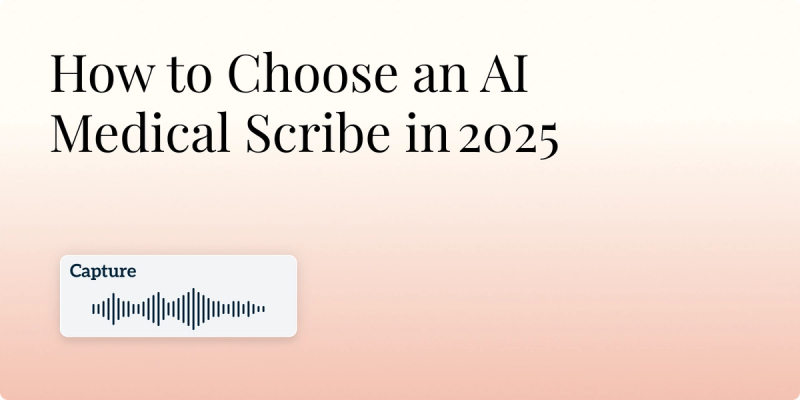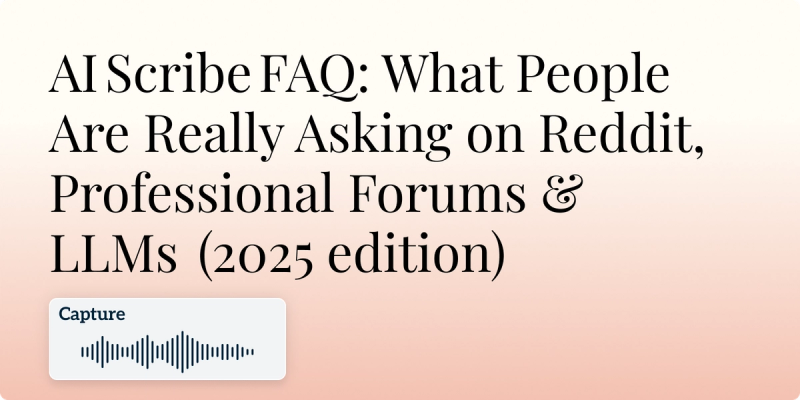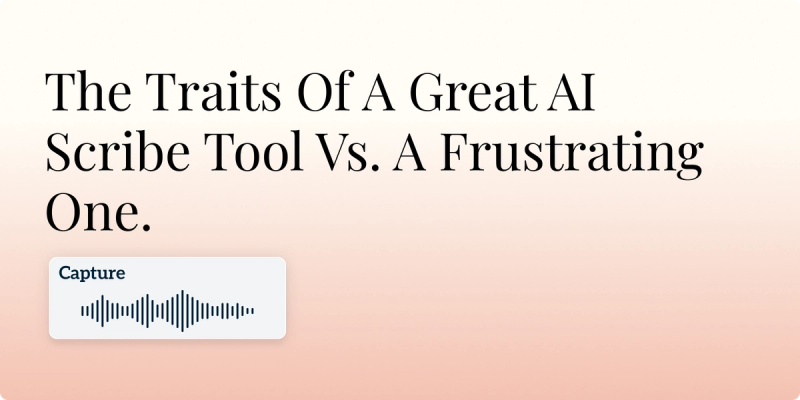
How to Choose the Best AI Medical Scribe Tool in 2025

Key Takeaways
- Knowing how to select an AI medical scribe boils down to 10 objective criteria.
- Run a structured pilot, capture metrics, and insist on transparent security docs.
- In 2025, the winners will be ambient, interoperable, and clinician‑controlled.
The explosion of generative AI has sparked a gold rush of “smart‑scribe” tools. Yet not all platforms are built ‑ or priced ‑ alike. If you’re wondering how to choose an AI medical scribe in 2025, this step‑by‑step listicle distills the noise into a practical buying guide, reinforced by a real‑world case study and insights from industry experts.
Quick 10‑Point Checklist
- HIPAA‑grade security & compliance
- ≥ 95 % specialty‑specific accuracy (not just generic benchmarks)
- Seamless EHR & telehealth integrations
- Real‑time vs. asynchronous note options
- Customizable templates and physician‑controlled edits
- Transparent audit trail & error‑generation logs
- Clear pricing tied to measurable ROI
- White‑glove onboarding and 24/7 support
- Data ownership remains with your practice
- Vendor’s AI ethics & roadmap (privacy, bias mitigation)
Bookmark this list; we’ll unpack each point next.
1. Confirm HIPAA, Security & Regulatory Compliance
“If a vendor can’t show proof of encryption in transit and at rest—plus a signed BAA—walk away.”
—Dr. Aisha Ramsey, MD, Chair of Digital Health Compliance, Stanford‑Packard Alliance
Beyond HIPAA, insist on SOC 2 Type II reports, penetration‑test summaries, and region‑specific regulations (e.g., GDPR, California CPRA).
2. Demand Specialty‑Level Accuracy, Not Generic Claims
Generic “95 %+” transcription accuracy often drops to 80‑85 % in psychiatry or pediatrics. Ask for blinded sample notes from your specialty, and run a pilot using clinical F‑score (precision × recall).
3. Check Workflow Integrations (EHR, Practice Management, Telehealth)
Look for API‑first architecture or existing App Marketplace listings (Epic App Orchard, Athenahealth Marketplace, etc.). Native integrations slash clicks and reduce cognitive load.
4. Decide Between Real‑Time vs. Async Note Generation
Real‑time scribes surface key data mid‑consult, aiding decision‑support. Asynchronous models (e.g., overnight batching) may be cheaper but delay documentation. Match turnaround speed to your clinical rhythm.
5. Prioritize Customization & Edit Controls
Providers need to tweak templates, insert abnormal findings, and lock critical sections. Audit whether the UI lets you:
- Add custom “smart phrases”
- Re‑run AI for specific sections only
- Track who edited what, and when
6. Insist on Transparent Audit Trails
An immutable, timestamped change‑log helps in medico‑legal disputes. Leading platforms expose token‑level diff views so you can pinpoint AI‑inserted phrases.
7. Calculate Pricing vs. ROI (Don’t Forget Hidden Fees)
Compare subscription tiers:
Cost Driver | Questions to Ask | Why It Matters |
|---|---|---|
Per‑note vs. per‑seat | “How many notes equal one billable unit?” | Controls scalability costs |
Overage pricing | “What if we exceed note limits?” | Avoid surprise bills |
Implementation fees | “Is onboarding included?” | Budget accuracy |
EHR integration fees | “Extra for HL7/FHIR?” | True TCO |
8. Assess Onboarding, Support & Training
A 14‑day “free trial” is worthless without:
- Dedicated Customer Success rep
- Live training webinars
- 24/7 in‑app chat with <5 min response times
9. Clarify Data Ownership & Portability
Your clinical data is an asset. Confirm you can export structured + unstructured data (JSON, HL7, TXT) on demand—especially if you migrate later.
10. Evaluate the Vendor’s AI Roadmap & Ethical Guardrails
With FDA interest in AI‑generated clinical content, grill vendors on:
- Bias audits and model‑drift monitoring
- Alignment with AMA’s Augmented Intelligence Code of Conduct
- Plans for multimodal (voice + video) capture
Case Study—How One Mental‑Health Group Cut Note Time by 76 %
- Practice: HopeBridge Behavioral Health (6 clinicians, Colorado)
- Problem: 12–15 min average note time, weekend backlog, 22 % no‑show revenue loss.
- Solution: Adopted an AI scribe (pilot: 3 licenses) with real‑time note drafting and EHR push.
- Results after 60 days:
Metric | Before | After | Δ |
|---|---|---|---|
Avg. note time | 13 min | 3.1 min | −76 % |
Clinician burnout score* | 3.8 | 2.1 | −1.7 |
Monthly revenue | $91 k | $110 k | +21 % |
*Maslach Burnout Inventory (1–5 scale)
“We recovered an entire clinic day each week. That’s five extra patient slots—without hiring scribes.”
—Katie Morales, PA‑C, Clinical Director, HopeBridge
Expert Round‑Up: What Leaders Look For in 2025
Expert | Quote |
|---|---|
Dr. Michael Chiang (Director, NIH NEI) | “Vendor lock‑in is the silent killer of innovation. Demand data portability from day one.” |
Jodi Uecker (Former Interim CEO, Epic) | “The future is ambient: scribes that understand context, not just dictation.” |
Andre Esteva, PhD (AI in Health author) | “Clinicians should own the decision, AI should own the draft. Keep that hierarchy clear.” |
Conclusion — Your Roadmap to the Best AI Medical Scribe
Choosing an AI medical scribe isn’t just about features—it’s about measurable impact on accuracy, clinician well‑being, and bottom‑line revenue. By applying the 10‑point framework above, piloting with real‑world metrics, and insisting on transparent security and support, you’ll position your practice to adopt the best AI medical scribe for 2025 and beyond.
Ready to see the checklist in action? Start a free trial with Twofold Health today and evaluate every criterion for yourself.
Frequently Asked Questions
ABOUT THE AUTHOR
Dr. Eli Neimark
Licensed Medical Doctor
Reduce burnout,
improve patient care.
Join thousands of clinicians already using AI to become more efficient.

AI Scribe FAQ: What People Are Really Asking on Reddit, Professional Forums & LLMs (2025 Edition)
Discover the real‑world questions clinicians ask about AI medical scribes - legality, HIPAA, accuracy, consent, specialty fit & more - answered by experts.

The Traits of a Great AI Scribe Tool vs. a Frustrating One
Don't waste time on an impractical AI scribe. Learn the key traits of a great one that saves time vs a frustrating one.

Best AI Scribe for Mental Health (2026) – Comparison, Pricing & More
Discover the 7 best AI scribes for mental‑health charting in 2026. Compare speed, pricing and HIPAA features to pick the best AI notes tool for your practice.

